A stakeholder is anyone who has a vested interest in a project. If your stakeholders aren’t satisfied with the results of a project, you’ve failed. Therefore, in order to successfully complete a project, it’s essential to gain a clear understanding of who your stakeholders are, what their expectations are and what motivates them. This process is called stakeholder analysis.
What Is Stakeholder Analysis?
Stakeholder analysis identifies and prioritizes stakeholders before the project begins. It organizes stakeholders into groups according to how much they participate in the project, what their interest level is and how much influence they have. Once these people are identified and organized, then you must figure out the best way to involve each stakeholder in the project, including the best channels for communication based on their needs.
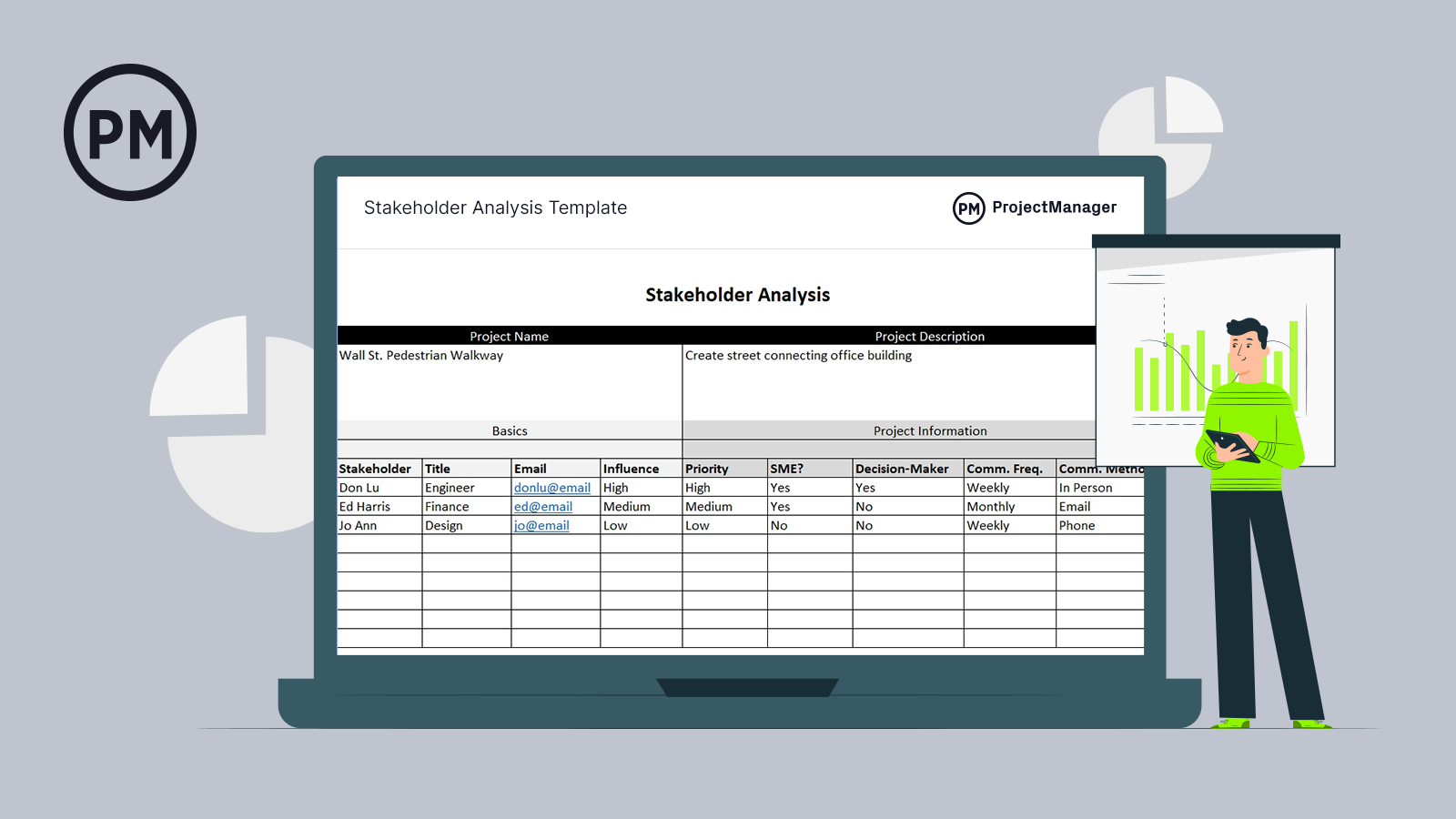
Get your free
Stakeholder Analysis Template
Use this free Stakeholder Analysis Template for Excel to manage your projects better.
Communication is key to stakeholder analysis because stakeholders must buy into and approve the project, and this can only be done with timely information and visibility into the project. The former puts the project in context while the latter builds trust. All this leads to the project being in strategic alignment with stakeholders and the overall business goals of the company.
Why Is Stakeholder Analysis Important?
Stakeholder analysis is a way to get help from key project players. Once you determine who these key stakeholders are, you can bring them into the project kickoff meeting to help align the project with strategic objectives. Their experience helps a project avoid pitfalls and getting their help builds stronger relationships. They can also help with conflict resolution during the project execution.
Stakeholders are also crucial for delivering the resources you need to get the project done right. When there is good communication between a stakeholder and a project manager, then the stakeholder can help deliver the people, tools and other resources necessary to get the project done.
The process of going through stakeholder analysis is also a way to build a relationship of trust with stakeholders. Once you have a line of communication open with stakeholders, develop a good rapport and show transparency in the project, you encourage trust. These elements should be considered in your stakeholder management plan. Project management software helps keep the lines of communication open between project managers and stakeholders.
Improve Stakeholder Management with ProjectManager
ProjectManager is award-winning project management software that has customizable reports that are easy to share with stakeholders to keep them updated. Use reports with our other project views to ensure stakeholders are properly managed throughout the project.
- Use filtered status reports or portfolio reports to manage stakeholder expectations
- Ensure quality at every project phase using automation and task approvals
- Share in-depth plans with stakeholders using free guest licences. Try it free
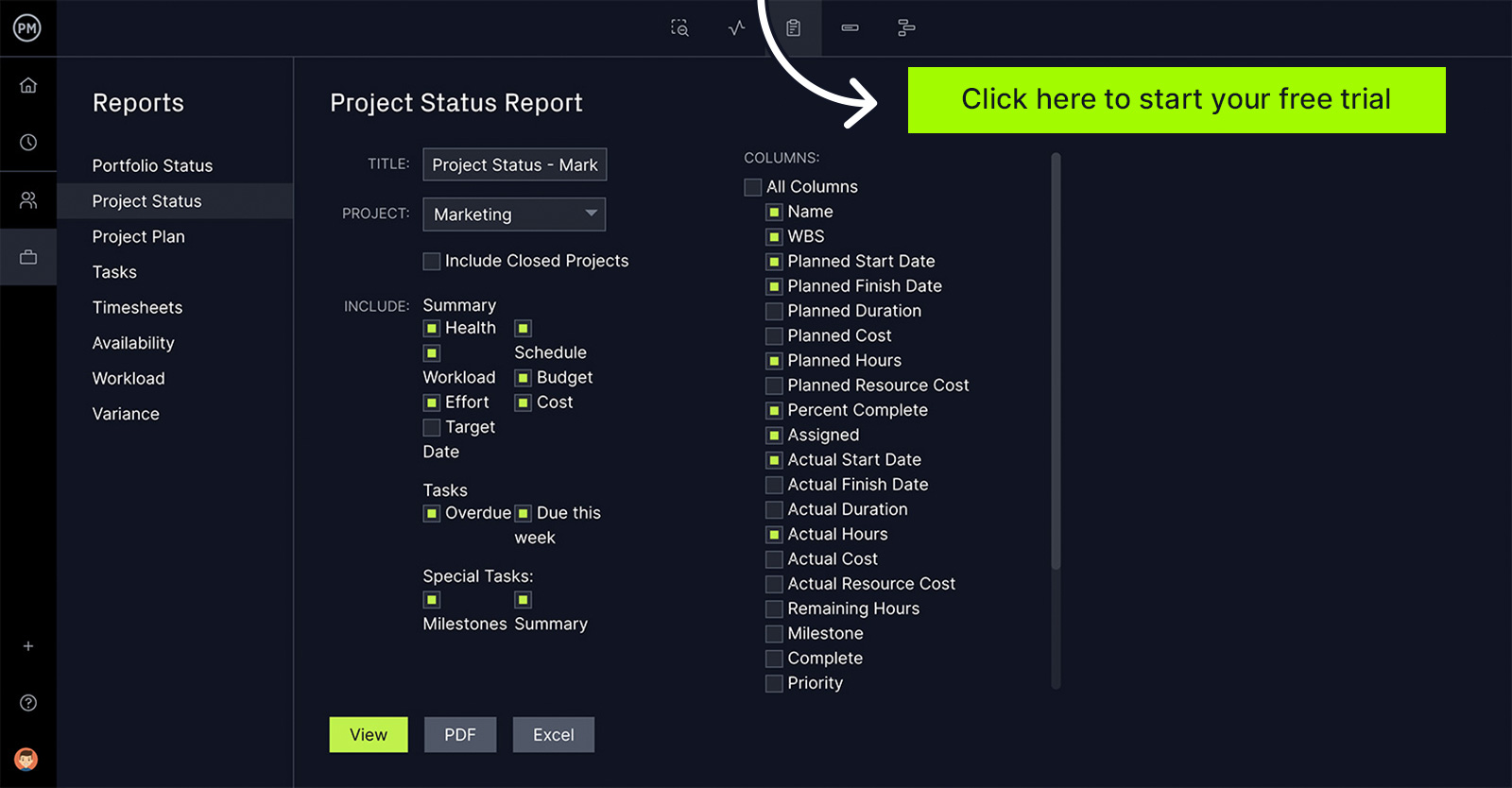
Stakeholder Analysis Steps
Stakeholder analysis uses a technique called stakeholder mapping. Before starting, you first must decide on the focus of the project. This will determine who is most important in terms of stakeholders. Once that is determined, you can download our free stakeholder map template and follow these steps.
1. List the Stakeholders
As noted above, stakeholders come in all shapes and sizes. While it’s important to narrow the focus that comes in later. At this point, you want to list everyone who is a stakeholder, no matter the level of their significance to the project. As you list your stakeholders, keep in mind that they fall into two main categories: those who are affected by the project and those who contribute to it.
For example, the project manager and the team are contributors to the project, while the end-user is someone who is affected by it. It’s possible that stakeholders fall into both categories. The better this list is, the less likely you’ll be delayed or sidetracked during the project.
2. Analyze Stakeholders
What are the roles and expectations of all those stakeholders that you have listed above? Some stakeholders are going to have more importance to the project and their expectations will have more of an impact than others. This is where you make those determinations.
You can discern this by using an influence-interest matrix, which is a box broken into four sections. You should place your stakeholders in one of the four boxes based on their interest and influence levels.
The top of the box is broken into two sections: keep informed and manage closely. The lower half of the box is also broken into two sections: minimal contact and keep satisfied. Anyone placed to the right of the box has more influence, while anyone placed near the top of the box has more interest. If a stakeholder is placed in the top right, then they have a lot of interest and influence, making them important players in the project.
3. Prioritize Stakeholders
Once you have a thorough list, you can begin prioritizing them by importance to the project. Decide who among them has the most influence on the project plan and is affected by it. You can use the influence-interest matrix again to help with prioritizing stakeholders.
Don’t forget that the status of your stakeholders is not static, they can change throughout the project. Stakeholder analysis is not a one-time thing but is a process that should continue throughout the project.
4. Engage Stakeholders
Finally, with the information created in your stakeholder map, you figure out how to engage your stakeholders. This is the process by which you win over stakeholders, and get their understanding and support to help fuel the project, putting it on the right course. This leads to a communication plan that outlines the channel and frequency of communications between you and each stakeholder. You can use our communication plan template to get started.
Stakeholder Analysis Template
ProjectManager has dozens of free project management templates for Excel and Word that can help manage projects throughout their life cycle. Use our free stakeholder analysis template for Excel to capture all the pertinent information you need to manage stakeholders’ expectations.
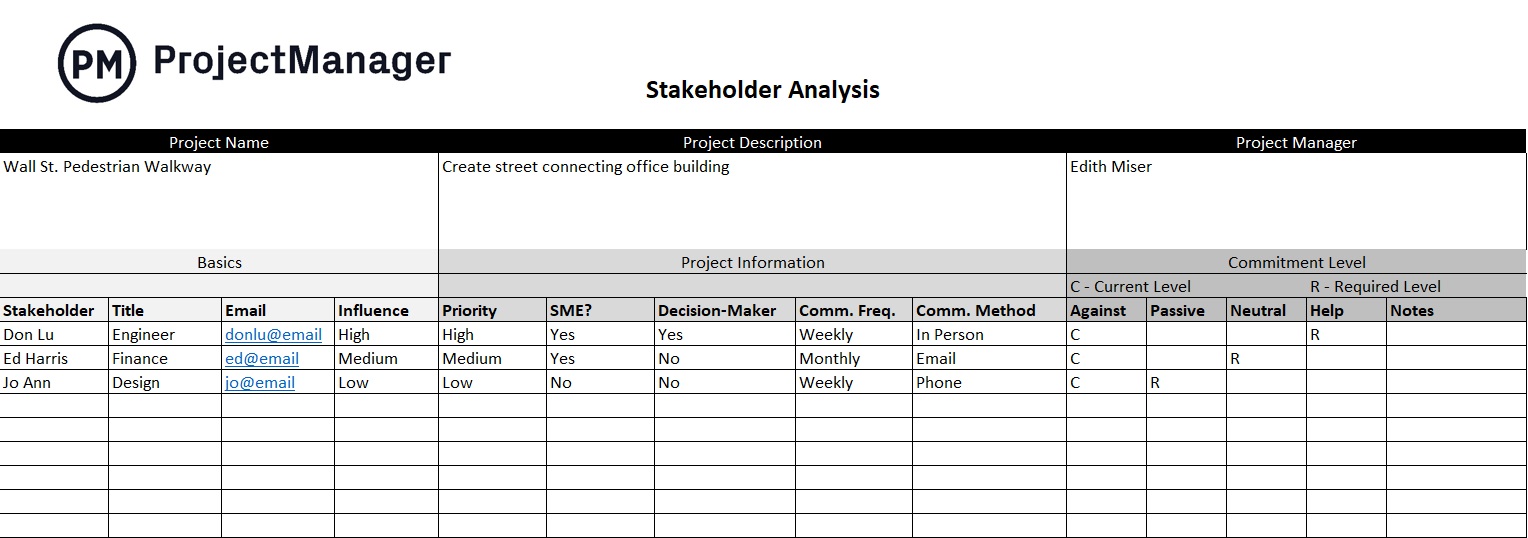
Stakeholder Analysis Example
To better understand what stakeholder analysis is look at a stakeholder analysis example. We’ll keep it simple, say hiring a contractor to build a playhouse for your child.
First, you want to list all the stakeholders, which includes the owner, you, and your child, but also the contractor you’ve hired for the project. Now, analyze those stakeholders. You have a high influence on the project and make the decisions, while your child has a medium influence as you want to build something the child will like. The contractor isn’t a decision-maker but has a high influence on the execution of the project.
Prioritize these stakeholders, such as you as owner will have the highest priority, the contractor next and the child last. In terms of engagement, you and the contractor will likely want to have daily discussions on the progress of the project. The child is probably only interested in the final delivery.
Stakeholder Analysis Tools
To excel at stakeholder analysis, you’ll need the proper tools. They will help you identify, prioritize and communicate with your stakeholders. Here are some that we recommend.
Stakeholder Map or Power/Interest Grid
A stakeholder map is a matrix that helps to categorize stakeholders. It helps with the analysis and management of stakeholders by mapping them to a grip that shows their power and interest in the project.
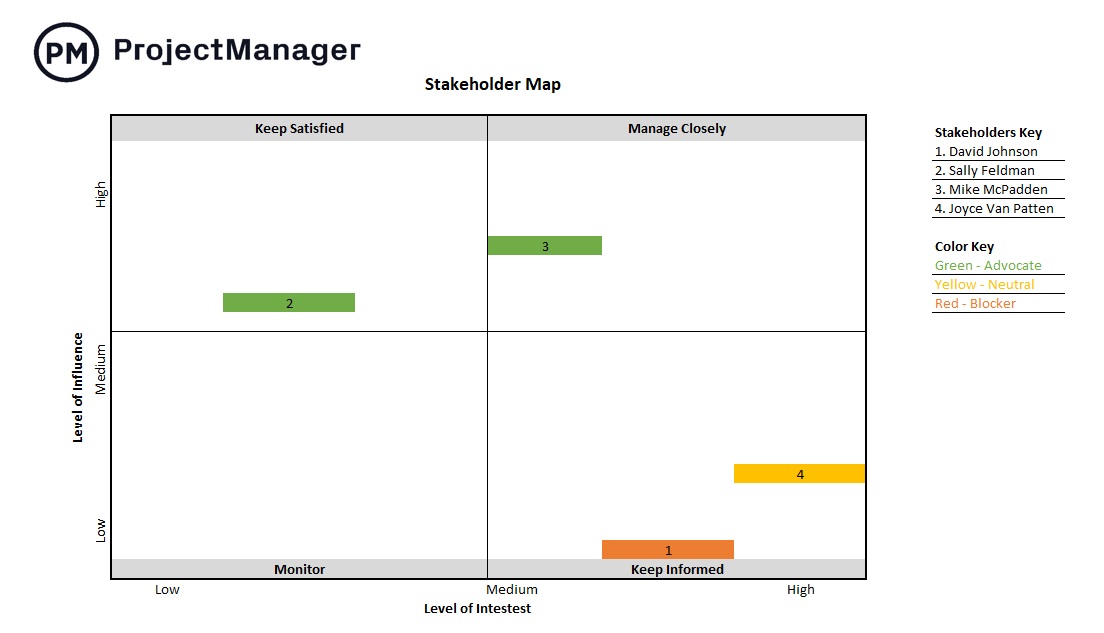
Stakeholder Knowledge Base Chart
This stakeholder analysis tool maps stakeholders based on their knowledge of the project and their attitude toward the project. It’s a box divided into four quadrants: aware/opposition, aware/support, ignorant, opposition and ignorant/support.
Stakeholder Salience Model
This model is used to define how much priority and attention a project manager should give to competing stakeholder claims. It does this by measuring each stakeholder’s power, legitimacy and urgency.
Stakeholder Onion Diagram
This analytical tool is used to figure out who are the stakeholders in the project and how each of the stakeholders’ roles interacts with the project. Like an onion, there’s a process or product at the center that’s surrounded by layers of stakeholders.
RACI Matrix
RACI is an acronym that stands for responsible, accountable, consulted and informed. This matrix then will define each stakeholder as one of those four letters in terms of activities or decision-making.
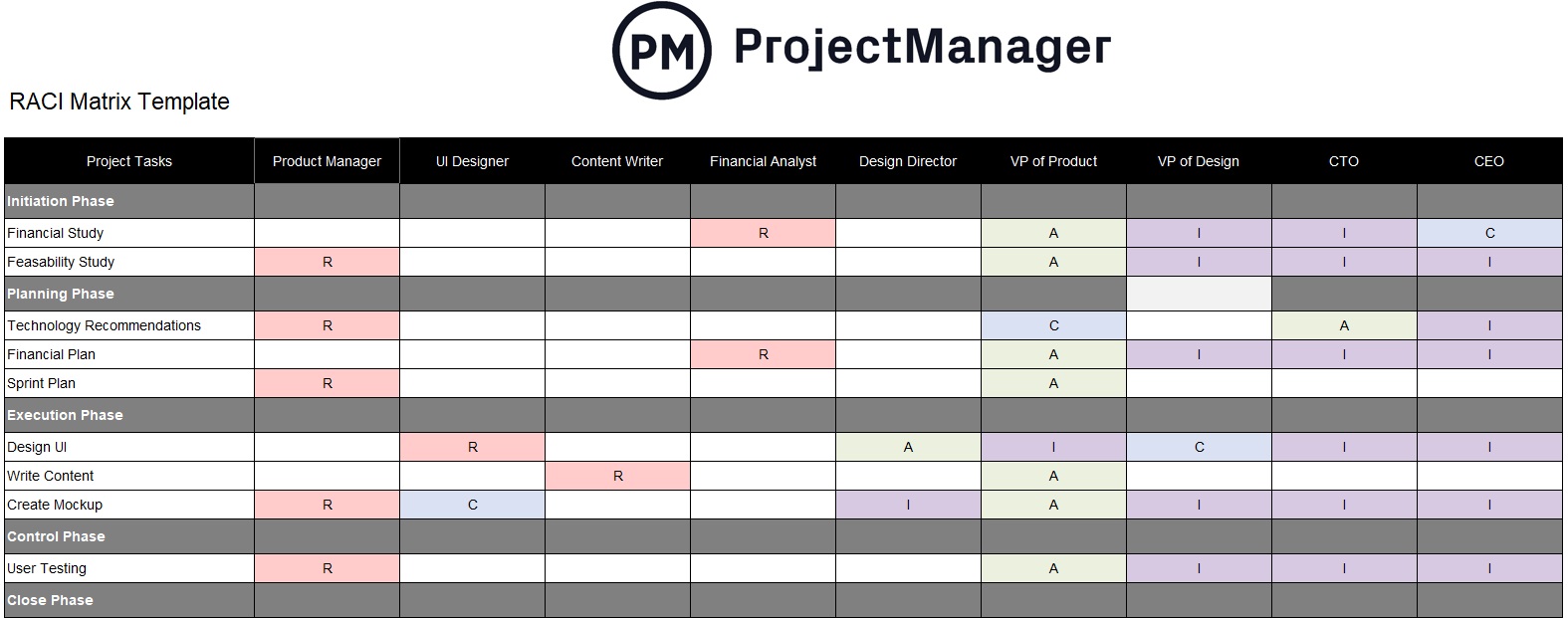
How ProjectManager Helps With Stakeholder Management
Once you’ve identified and analyzed your stakeholders, you’re going to have to work with them. That’s where ProjectManager comes in. Our award-winning project management software has all the tools you need to manage your projects and keep your stakeholders engaged.
Reporting
Naturally, stakeholders have an interest in the project. But, that doesn’t mean you have to give them every detail. Sometimes it’s the big picture that counts. ProjectManager has a real-time dashboard that paints the project in broad strokes, such as task progress, costs and project variance. These colorful graphs and charts make it easy to see where the project is right now.

Unlimited File Storage
Projects make paperwork. Stakeholders like those business cases and want to have access to them. ProjectManager has unlimited file storage, so add as many project-related documents and images as you like. Everything is in one place and easy to find. Keep stakeholders happy.
ProjectManager is online project management software that helps project managers manage their projects, teams and stakeholders. With planning, tracking and reporting tools, managers and teams are prepared for every project phase. See how ProjectManager can support you and your stakeholders with this free 30-day trial.

